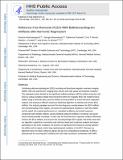| dc.contributor.author | Bonmassar, Giorgio | |
| dc.contributor.author | Poulsen, Catherine | |
| dc.contributor.author | Pierce, Eric T. | |
| dc.contributor.author | Purdon, Patrick L. | |
| dc.contributor.author | Krishnaswamy, Pavitra | |
| dc.contributor.author | Brown, Emery Neal | |
| dc.date.accessioned | 2017-11-02T18:18:18Z | |
| dc.date.available | 2017-11-02T18:18:18Z | |
| dc.date.issued | 2015-07 | |
| dc.date.submitted | 2015-01 | |
| dc.identifier.issn | 1053-8119 | |
| dc.identifier.uri | http://hdl.handle.net/1721.1/112124 | |
| dc.description.abstract | Combining electroencephalogram (EEG) recording and functional magnetic resonance imaging (fMRI) offers the potential for imaging brain activity with high spatial and temporal resolution. This potential remains limited by the significant ballistocardiogram (BCG) artifacts induced in the EEG by cardiac pulsation-related head movement within the magnetic field. We model the BCG artifact using a harmonic basis, pose the artifact removal problem as a local harmonic regression analysis, and develop an efficient maximum likelihood algorithm to estimate and remove BCG artifacts. Our analysis paradigm accounts for time-frequency overlap between the BCG artifacts and neurophysiologic EEG signals, and tracks the spatiotemporal variations in both the artifact and the signal. We evaluate performance on: simulated oscillatory and evoked responses constructed with realistic artifacts; actual anesthesia-induced oscillatory recordings; and actual visual evoked potential recordings. In each case, the local harmonic regression analysis effectively removes the BCG artifacts, and recovers the neurophysiologic EEG signals. We further show that our algorithm outperforms commonly used reference-based and component analysis techniques, particularly in low SNR conditions, the presence of significant time-frequency overlap between the artifact and the signal, and/or large spatiotemporal variations in the BCG. Because our algorithm does not require reference signals and has low computational complexity, it offers a practical tool for removing BCG artifacts from EEG data recorded in combination with fMRI. | en_US |
| dc.description.sponsorship | National Institutes of Health (U.S.) (Award DP1-OD003646) | en_US |
| dc.description.sponsorship | National Institutes of Health (U.S.) (Award TR01-GM104948) | en_US |
| dc.description.sponsorship | National Institutes of Health (U.S.) (Grant R44NS071988) | en_US |
| dc.description.sponsorship | National Institute of Neurological Diseases and Stroke (U.S.) (Grant Grant R44NS071988) | en_US |
| dc.publisher | Elsevier | en_US |
| dc.relation.isversionof | http://dx.doi.org/10.1016/J.NEUROIMAGE.2015.06.088 | en_US |
| dc.rights | Creative Commons Attribution-NonCommercial-NoDerivs License | en_US |
| dc.rights.uri | http://creativecommons.org/licenses/by-nc-nd/4.0/ | en_US |
| dc.source | PMC | en_US |
| dc.title | Reference-free removal of EEG-fMRI ballistocardiogram artifacts with harmonic regression | en_US |
| dc.type | Article | en_US |
| dc.identifier.citation | Krishnaswamy, Pavitra et al. “Reference-Free Removal of EEG-fMRI Ballistocardiogram Artifacts with Harmonic Regression.” NeuroImage 128 (March 2016): 398–412 © 2015 Elsevier Inc | en_US |
| dc.contributor.department | Institute for Medical Engineering and Science | en_US |
| dc.contributor.department | Harvard University--MIT Division of Health Sciences and Technology | en_US |
| dc.contributor.department | Massachusetts Institute of Technology. Department of Brain and Cognitive Sciences | en_US |
| dc.contributor.mitauthor | Krishnaswamy, Pavitra | |
| dc.contributor.mitauthor | Brown, Emery Neal | |
| dc.relation.journal | NeuroImage | en_US |
| dc.eprint.version | Author's final manuscript | en_US |
| dc.type.uri | http://purl.org/eprint/type/JournalArticle | en_US |
| eprint.status | http://purl.org/eprint/status/PeerReviewed | en_US |
| dc.date.updated | 2017-10-26T17:20:11Z | |
| dspace.orderedauthors | Krishnaswamy, Pavitra; Bonmassar, Giorgio; Poulsen, Catherine; Pierce, Eric T.; Purdon, Patrick L.; Brown, Emery N. | en_US |
| dspace.embargo.terms | N | en_US |
| dc.identifier.orcid | https://orcid.org/0000-0003-2668-7819 | |
| mit.license | PUBLISHER_CC | en_US |

